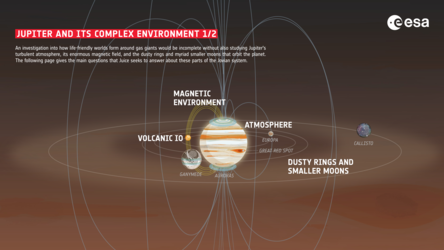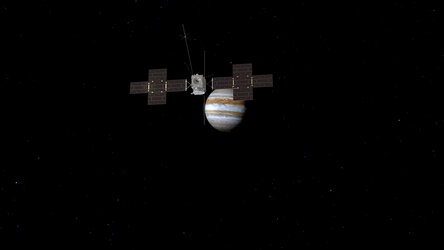Accept all cookies Accept only essential cookies See our Cookie Notice

About ESA
The European Space Agency (ESA) is Europe’s gateway to space. Its mission is to shape the development of Europe’s space capability and ensure that investment in space continues to deliver benefits to the citizens of Europe and the world.
Highlights
ESA - United space in Europe
This is ESA ESA facts Member States & Cooperating States Funding Director General Top management For Member State Delegations European vision European Space Policy ESA & EU Space Councils Responsibility & Sustainability Annual Report Calendar of meetings Corporate newsEstablishments & sites
ESA Headquarters ESA ESTEC ESA ESOC ESA ESRIN ESA EAC ESA ESAC Europe's Spaceport ESA ESEC ESA ECSAT Brussels Office Washington OfficeWorking with ESA
Business with ESA ESA Commercialisation Gateway Law at ESA Careers Cyber resilience at ESA IT at ESA Newsroom Partnerships Merchandising Licence Education Open Space Innovation Platform Integrity and Reporting Administrative Tribunal Health and SafetyMore about ESA
History ESA Historical Archives Exhibitions Publications Art & Culture ESA Merchandise Kids Diversity ESA Brand Centre ESA ChampionsLatest
Space in Member States
Find out more about space activities in our 23 Member States, and understand how ESA works together with their national agencies, institutions and organisations.
Science & Exploration
Exploring our Solar System and unlocking the secrets of the Universe
Go to topicAstronauts
Missions
Juice Euclid Webb Solar Orbiter BepiColombo Gaia ExoMars Cheops Exoplanet missions More missionsActivities
International Space Station Orion service module Gateway Concordia Caves & Pangaea BenefitsLatest
Space Safety
Protecting life and infrastructure on Earth and in orbit
Go to topicAsteroids
Asteroids and Planetary Defence Asteroid danger explained Flyeye telescope: asteroid detection Hera mission: asteroid deflection Near-Earth Object Coordination CentreSpace junk
About space debris Space debris by the numbers Space Environment Report In space refuelling, refurbishing and removingSafety from space
Clean Space ecodesign Zero Debris Technologies Space for Earth Supporting Sustainable DevelopmentApplications
Using space to benefit citizens and meet future challenges on Earth
Go to topicObserving the Earth
Observing the Earth Future EO Copernicus Meteorology Space for our climate Satellite missionsCommercialisation
ESA Commercialisation Gateway Open Space Innovation Platform Business Incubation ESA Space SolutionsEnabling & Support
Making space accessible and developing the technologies for the future
Go to topicBuilding missions
Space Engineering and Technology Test centre Laboratories Concurrent Design Facility Preparing for the future Shaping the Future Discovery and Preparation Advanced Concepts TeamSpace transportation
Space Transportation Ariane Vega Space Rider Future space transportation Boost! Europe's Spaceport Launches from Europe's Spaceport from 2012Latest

Jupiter and its complex environment 2/2
Thank you for liking
You have already liked this page, you can only like it once!
As the name suggests, a strong focus of ESA’s Jupiter Icy Moons Explorer (Juice) is to explore the subsurface oceans of Jupiter’s icy moons. But an investigation into how life-friendly worlds form around gas giants would be incomplete without also studying Jupiter's turbulent atmosphere, its enormous magnetic field, and the dusty rings and myriad smaller moons that orbit the planet.
Atmosphere: Jupiter’s ever-changing atmosphere has been a source of curiosity since the Solar System’s most famous storm – the churning Great Red Spot – was first glimpsed in the 17th century. Juice will use four unique instruments to answer questions such as: What is the weather and climate like on Jupiter? How does an atmosphere work when there is no solid surface? What could be making Jupiter’s upper atmosphere so unexpectedly hot?
Magnetic environment: Jupiter’s complex magnetic environment is one of the Solar System’s outstanding mysteries. The planet’s rapidly rotating metallic liquid hydrogen core generates a magnetic field, which is thought to be 20 times stronger than that of Earth, and one million times larger in volume. Juice will study the region of space around Jupiter that is dominated by this magnetic field – the magnetosphere – to discover how the harsh environment shaped and continues to shape conditions on the icy moons.
Volcanic Io and Jupiter’s invisible rings: Aside from the large icy moons that Juice will get close to and explore in depth (Ganymede, Europa and Callisto) Juice will also observe the fourth ‘Galilean moon’ – eruptive Io – from a distance. As the most volcanically active body in the Solar System, Io will be another target for Juice. On this fiery world, volcanoes soar up to around 18 km in height, and eruptions can last years. These eruptions blast out charged particles that are carried around Jupiter and towards Ganymede and Europa. Juice will monitor Io’s volcanic activity and investigate what its surface is made of.
Dusty rings and smaller moons: In total, Jupiter is surrounded by almost 80 moons, as well as rings of tiny dust particles. Whilst Saturn’s rings shine loud and clear, it wasn’t until 1979 that Jupiter’s more subtle ring system was discovered by astronomers. The age of these rings is still unknown, but various processes in Jupiter’s fierce environment destroy small dust particles, meaning that something must be constantly replenishing the rings if they are to live for very long. By imaging the rings in 3D from different angles, and analysing them in various wavelengths of light to find out what exactly they are made of, Juice will help us understand more about their physics and chemistry.
See these four elements of the Jovian system in context in the first part of this infographic. Discover more about Jupiter and its complex environment in our dedicated article.
Juice will make detailed observations of Jupiter and its three large ocean-bearing moons – Ganymede, Callisto and Europa – with a suite of instruments. The mission will characterise these moons as both planetary objects and possible habitats, explore Jupiter’s complex environment in depth, and study the wider Jupiter system as an archetype for gas giants across the Universe.
-
CREDIT
ESA -
ACKNOWLEDGEMENTS
ATG Europe -
LICENCE
CC BY-SA 3.0 IGO or ESA Standard Licence
(content can be used under either licence)

Jupiter and its complex environment 1/2

Jupiter’s magnetic environment

Juice orbiting Jupiter (artist’s impression)

Juice in a nutshell















 Germany
Germany
 Austria
Austria
 Belgium
Belgium
 Denmark
Denmark
 Spain
Spain
 Estonia
Estonia
 Finland
Finland
 France
France
 Greece
Greece
 Hungary
Hungary
 Ireland
Ireland
 Italy
Italy
 Luxembourg
Luxembourg
 Norway
Norway
 The Netherlands
The Netherlands
 Poland
Poland
 Portugal
Portugal
 Czechia
Czechia
 Romania
Romania
 United Kingdom
United Kingdom
 Slovenia
Slovenia
 Sweden
Sweden
 Switzerland
Switzerland

























